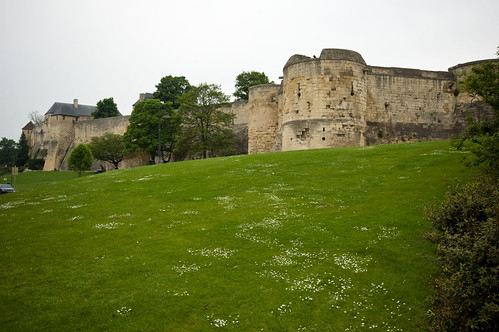Barbacane de la Porte des
Champs
L'entrée initiale au nord, protégée par une tour-porte, disparaît
vert 1220 avec la construction de la courtine du donjon par
Philippe-Auguste. À l'est, l'imposante Porte des Champs (ou porte
de la Pigacière, porte du Vaugueux et ultérieurement porte de
Secours) est sans doute construite au moment de la disparition de
la porte nord ; munie d'un pont-levis, et précédée dès l'origine
d'un avant-corps, elle accentue encore les défenses de la
forteresse. Elle était constituée à l’origine de deux tours
accolées. Ces deux tours furent ensuite – au XIVe siècle
peut-être – reliées par un mur de maçonnerie, donnant ainsi à
la porte la forme générale qu’elle conserve
aujourd’hui. Pendant l’occupation anglaise de la ville
et du château (1417-1450), le capitaine du château, John Fastolf,
fait réaménager la porte ; les mâchicoulis la surplombant sont
construits à cette époque.
 La Barbacane (à droite) par Djof
(flickr)
La Barbacane (à droite) par Djof
(flickr)
L’origine de la barbacane la précédent est mal connue. Elle a
peut-être été construite dans le second quart du XIVe siècle pour
se protéger des Anglais. Mais il est possible qu’elle ait
existé dès le XIIIe siècle. La reconstruction de cet ouvrage après
les bombardements de 1944 a privé les archéologues de la
possibilité de mener une étude exhaustive permettant sa
datation.
Source :
site du château de Caen et Joseph Decaëns, Adrien Dubois
(dir.),
Le château de Caen. Mille ans d’une forteresse
dans la ville, Caen, CRAHM, 2009, pp.60–63
Plus d'informations sur les
Barbacane sur
Wikipedia
The castle and his
Barbican
The
Château de
Caen is located in the center of the city, streets fanning
around like a star. The castle was built by Guillaume II de
Normandie in 1060. People called him Le Bâtard (The Bastard)
because he was the illegitimate son of the previous Normandy Duke,
Robert I. That all changed six years later, after having conquered
the whole of England, he became known as
Guillaume le
Conquérant (William the Conqueror) and in England, William I of
England.
The picture shows only a small part of the South-West wall and a
part of the South barbican. The whole castle is truly enormous.
Have a walk ! There is another cache inside !
The South entrance named Porte de la ville (Door to the city) or
Porte St-Pierre (Door St. Peter) is an interesting piece of
defensive design and architecture. The ramparts themselves are very
high, sitting on top of a cliff face, much too high for ladders.
The barbican (small external fort) protecting the entrance is
located below, with walls reaching about half as high as the
castle. The only way to get in the castle is to first take the draw
bridge to the barbican, then from there, take another draw bridge
to the castle. If the barbican ever came to fall during an attack,
the attackers would still be vulnerable to fire from the main
walls. If despite this the attackers managed to make it inside the
gate, they would find themselves in a pit, locked up behind a
second gate, once again vulnerable to fire from above. Brilliant,
no?
Source :
Caen castle website
More informations about
Barbicans on
Wikipedia
Good luck !